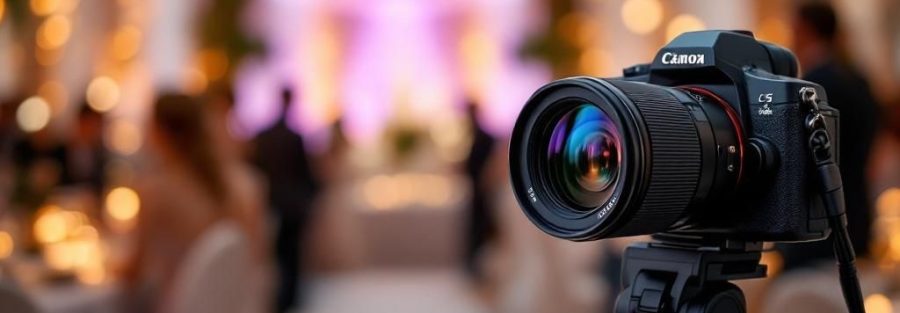When you're trying to pick the best camera for event photography, a few names always pop up: the Sony A7 IV, the Canon EOS R6 Mark II, and the Nikon Z6 II. These cameras are mainstays for a reason. They kill it in low light, have autofocus that seems to read your mind, and are built to withstand the chaos of a live event—all must-haves for this line of work.
Getting to Know the Top Cameras for Events
Picking the right camera isn't about brand loyalty anymore. It's about finding a tool that performs under pressure, especially in the tricky, fast-paced environments that define event photography. The industry has really leaned into mirrorless cameras, and it's easy to see why. You get incredible tech packed into a lighter body, which is a lifesaver when you're on your feet for 8-10 hours straight.
The goal is to match the camera's strengths to the kind of events you shoot. Are you in dimly lit wedding reception halls or bright, wide-open corporate conferences? The answer will guide your choice.
There are really three things that make or break an event camera:
- Autofocus (AF) System: A great AF system isn't just fast—it's smart. You need a camera with sophisticated subject detection, especially for locking onto a person's eye and not letting go, even when they're moving through a crowd.
- Low-Light Capability: Let's be real, event lighting is almost never perfect. A full-frame sensor with a high native ISO range is your best friend here. It lets you crank up the settings without turning your photos into a noisy mess.
- Speed and Reliability: This is a two-parter. You need a fast burst rate to catch that perfect split-second expression, plus a deep buffer so your camera doesn't freeze while writing images. And dual card slots? Absolutely non-negotiable. A corrupted card can ruin a whole gig.
The secret isn't just one killer feature, but how all the pieces work together when the pressure is on. The best camera is one that feels like an extension of your own hands and just works without you having to fight it.
And if your events ever call for a bird's-eye view, you might want to look into the best drones for professional photography to add a unique perspective.
A Quick Look at the Top Contenders
To get a feel for how these cameras stack up for event work, here’s a quick breakdown of where each one really shines.
| Feature | Sony A7 IV | Canon EOS R6 Mark II | Nikon Z6 II |
|---|---|---|---|
| Autofocus Strength | AI-powered, real-time tracking that sticks to anything | Insanely good at tracking people and vehicles | Super reliable and snappy, a solid all-rounder |
| Low-Light Performance | Fantastic. Delivers clean, sharp images at high ISOs | Top-tier, arguably one of the best in its class | Very strong performer with excellent dynamic range |
| Key Advantage | The autofocus is just on another level of smart and accurate | A speed demon that also masters low-light situations | Feels amazing in the hand with a tough, durable build |
What Truly Matters in an Event Camera
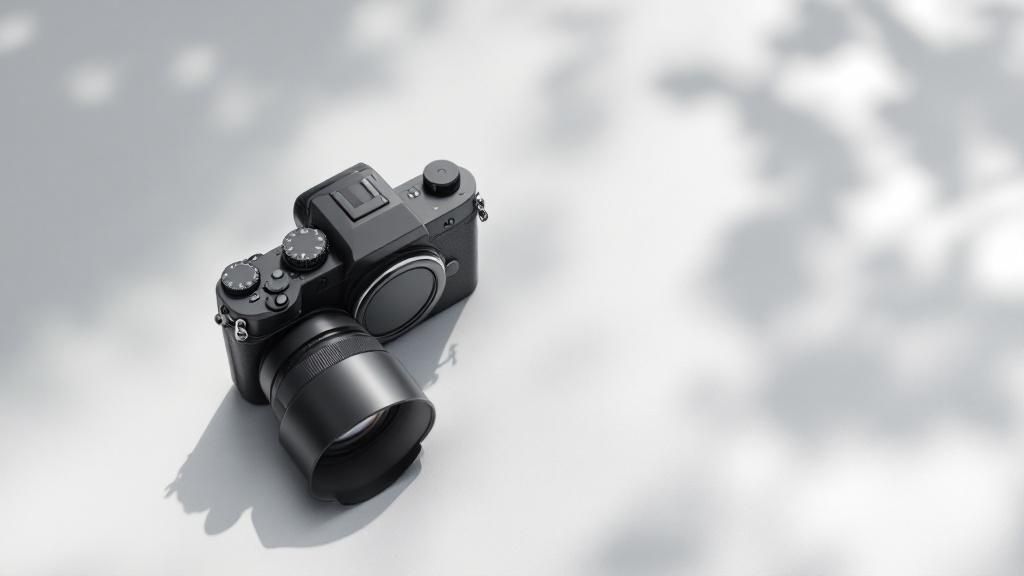
Before we start comparing specific models, let's talk about what actually makes a camera great for events. It’s way too easy to get bogged down in spec sheets and marketing hype. The truth is, only a few key features separate the workhorses from the toys when you're in the middle of a chaotic, fast-moving event.
Getting a handle on these fundamentals is your best defense against buyer's remorse. It lets you look past the noise and judge a camera based on what will help you nail the shot when the pressure's on. This isn't just about a high megapixel count; it's about how the camera performs under fire.
And the need for skilled event photographers is huge. Event work makes up a massive 32.5% of the entire photographic services market. To get a piece of that pie, you need gear that can keep up, especially with autofocus and low-light shooting.
Autofocus That Never Misses
If there's one feature that can make or break an event camera, it's the autofocus (AF) system. Plain and simple. You don't get do-overs at a live event. You need an AF that's not just fast but smart—something that can lock onto an eye and stick to it while your subject is moving, dancing, or weaving through a crowd.
This is where modern mirrorless cameras have completely changed the game, using some seriously clever algorithms to track subjects with incredible accuracy. Picture yourself shooting a wedding reception: solid eye-AF means you can forget about focus-hunting and just concentrate on your composition, trusting the camera to keep the bride tack-sharp as she's laughing with her guests.
A great autofocus system should feel like it's reading your mind. It anticipates movement and sticks to your subject, freeing you up to focus on the art of the shot, not the technical struggle of achieving focus in a dimly lit, crowded room.
Nailing this is how you capture those candid, perfect moments that clients pay for. It’s a total game-changer.
Conquering Low Light Conditions
Let’s be real: events are rarely held in perfectly lit studios. From moody wedding venues and dark conference halls to corporate parties after sunset, your camera has to deliver when the lights go down. This is where high ISO performance is make-or-break.
A camera with a good full-frame sensor and a powerful processor can be pushed to high ISOs—think ISO 6400 or even 12800—and still give you clean, usable images without a ton of ugly digital noise. This capability means you can keep your shutter speed high enough to freeze motion without blasting everything with a flash, which helps preserve the natural vibe of the room. The photos just feel more authentic.
If you're looking for other ways to boost the visual fun at an event, check out our guide on how a photo booth for a wedding reception can make a huge impact.
Essential Professional Safeguards
Beyond just taking the picture, a professional camera has to protect your work. For anyone shooting events for a living, a couple of features are completely non-negotiable.
-
Dual Card Slots: This is your career insurance policy. The camera writes every single photo to two memory cards at once. If one card decides to die—and trust me, it can happen—you have a complete backup on the second card. It saves your reputation and the client's priceless memories.
-
Silent Shutter Mode: The loud clack of a mechanical shutter is the last thing you want during a quiet wedding ceremony, a CEO's big speech, or an awards presentation. A silent electronic shutter lets you keep shooting without being a distraction. You become a ghost, capturing moments without interrupting them.
Comparing the Top Event Photography Cameras
https://www.youtube.com/embed/aiZDY1ZNwfA
Alright, let's get to the main event: the head-to-head showdown. It's time to stop talking in general terms and see how these top-tier cameras actually stack up when the lights are low and the pressure is on. We’re putting today’s most popular full-frame mirrorless cameras under the microscope to see which one really deserves to be called the best camera for event photography.
I'm not just going to rattle off a list of specs. We’re going to look at these cameras through the lens of real-world event scenarios. Think about a chaotic wedding reception dance floor, a dimly lit corporate awards ceremony, or a fast-paced concert. How a camera handles those moments is what truly matters to a working pro.
We’ll focus on three of the heavy hitters in the game: the Sony A7 IV, the Canon EOS R6 Mark II, and the Nikon Z6 II. Each has its own philosophy and brings a unique set of strengths to the table, making this a really interesting comparison.
Head-to-Head Camera Spec Comparison
Before we dive deep into the real-world feel, let's lay the groundwork with a quick spec comparison. These are the numbers that define the technical capabilities of each camera and are crucial for understanding their performance potential.
| Feature | Sony A7 IV | Canon EOS R6 Mark II | Nikon Z6 II | Fujifilm X-H2S |
|---|---|---|---|---|
| Sensor | 33 MP Full-Frame BSI CMOS | 24.2 MP Full-Frame CMOS | 24.5 MP Full-Frame BSI CMOS | 26.1 MP APS-C Stacked BSI CMOS |
| ISO Range | 100-51200 (Exp. 50-204800) | 100-102400 (Exp. 50-204800) | 100-51200 (Exp. 50-204800) | 160-12800 (Exp. 80-51200) |
| Autofocus | 759-Point Hybrid AF | Dual Pixel CMOS AF II | 273-Point Hybrid AF | 425-Point Hybrid AF |
| Max Burst | 10 fps (Mechanical) | 40 fps (Electronic), 12 fps (Mechanical) | 14 fps (Mechanical) | 40 fps (Electronic), 15 fps (Mechanical) |
| Video | 4K 60p (1.5x crop), 4K 30p (Full) | 4K 60p (Full), 6K RAW (Ext.) | 4K 60p (1.5x crop), 4K 30p (Full) | 4K 120p, 6.2K 30p (Open Gate) |
While specs on a page don't tell the whole story, this table highlights the key battlegrounds: Canon's incredible speed, Sony's resolution advantage, and Fujifilm's impressive video chops in an APS-C body. Now, let's see how these numbers translate into actual performance.
Autofocus: The Real-World Test
In event photography, autofocus is where the battle is won or lost. A missed shot of the CEO’s handshake or a blurry photo of the first kiss isn't a "do-over" moment. This is where the subtle differences between these incredible systems really show themselves.
The Sony A7 IV is famous for its AI-powered autofocus, and honestly, the hype is justified. Its Real-time Tracking is almost psychic. Imagine you're covering a big conference; you can tap on a speaker's face on the screen, and the camera will stick to them like glue as they pace the stage, even if they turn away or someone walks in front of them. It's just relentless.
Then you have the Canon EOS R6 Mark II. Canon has polished its Dual Pixel CMOS AF II system to be scarily good at finding and tracking people. For wedding photographers, its eye detection is arguably the most tenacious in the business. Once that R6 Mark II locks onto the bride's eye as she walks down the aisle, it just does not let go. It gives you the confidence to stop worrying about focus and just nail the composition.
The Nikon Z6 II holds its own with a quick and dependable 273-point hybrid AF system. It might not have the flashy "AI" branding of the Sony, but its performance is rock-solid and predictable. For corporate jobs or simple grip-and-grin photos, its 3D-tracking is fantastic for capturing sharp images of people who are either standing still or moving in a fairly predictable way.
For pure, unyielding subject tracking in the most chaotic environments, the Sony A7 IV has a slight edge with its AI processing. However, the Canon EOS R6 Mark II’s ability to find and lock onto a human eye is so dependable it feels like a superpower for wedding and portrait-focused event shooters.
Low Light Performance and Image Quality
Let's be real: event venues are famous for terrible lighting. Getting clean, detailed images at high ISOs isn't a nice-to-have; it's a must. This is where a camera's sensor and processing engine earn their keep.
The Canon EOS R6 Mark II is an absolute monster in low light. Its 24.2 MP sensor seems to be the sweet spot for delivering stunningly clean files, even when you have to crank the ISO up to 12,800 or higher. The colors stay rich and the noise is handled beautifully, meaning less time spent on cleanup in post. If you're constantly shooting in dark reception halls or concert venues, this camera is a dream.
With its higher-resolution 33 MP sensor, the Sony A7 IV gives you incredible detail. While more pixels can sometimes lead to more noise, Sony’s processing engine is top-notch. You get a ton of flexibility to crop in post, which can be a lifesaver. The image quality is fantastic, though some might argue the Canon’s files look a touch cleaner at the absolute highest ISO settings.
The Nikon Z6 II is no slouch here, either. Its 24.5 MP sensor produces beautiful, clean images with excellent dynamic range. Many photographers swear by Nikon’s color science, which is known for producing natural and pleasing skin tones straight out of the camera—a huge time-saver in editing. It's a fantastic all-around performer in low light, delivering professional results time and time again.
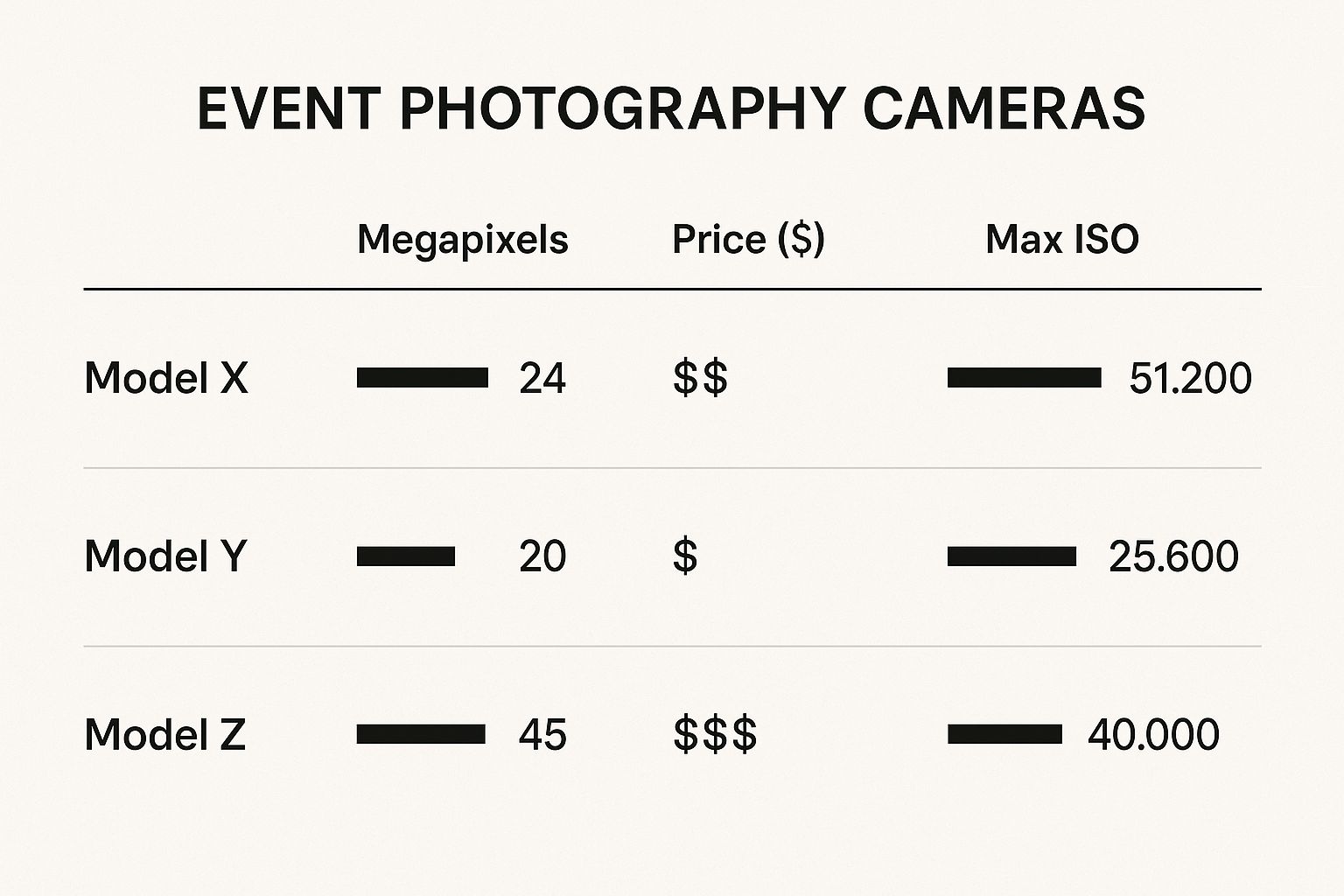
As you can see, all three have impressive ISO capabilities. The real differentiators come down to the resolution you need and the price point that fits your business.
Speed and Handling for Your Workflow
An event camera needs to feel like an extension of your arm. Ergonomics, button layout, and shooting speed have a direct impact on your ability to capture those fleeting, unscripted moments. If you're fighting with your camera, you're losing shots.
When it comes to raw speed, the Canon EOS R6 Mark II is in a league of its own, boasting a blistering 40 frames per second with the electronic shutter. This is wild for capturing the absolute peak of the action, like the confetti pop on New Year's Eve or the bouquet toss at a wedding. Plus, its ergonomics are classic Canon—comfortable, intuitive, and instantly familiar to many photographers.
The Sony A7 IV clocks in at a more modest 10 fps, but that's still plenty for most event situations. Where Sony really shines is in its customizability. You can program almost every button to fit your specific workflow, making the camera incredibly efficient once you've got it dialed in. Its compact size is also a nice bonus on a long 12-hour wedding day.
Many photographers will tell you the Nikon Z6 II has the best ergonomics of the bunch. It just feels right in your hand, with a deep, comfortable grip that inspires confidence. It shoots at a very respectable 14 fps and has a menu system that is logical and easy to navigate, which is a huge plus when you need to change a setting in a hurry.
Your camera choice should empower your creativity, especially when you're trying to execute fresh concepts. For some inspiration, take a look at our guide on top unique event ideas that will definitely put your gear to the test.
Ultimately, choosing between these three powerhouses really comes down to your personal needs and shooting style. Each one is a phenomenal tool more than capable of delivering stunning results in the demanding world of event photography.
How to Choose a Camera for Your Event Niche
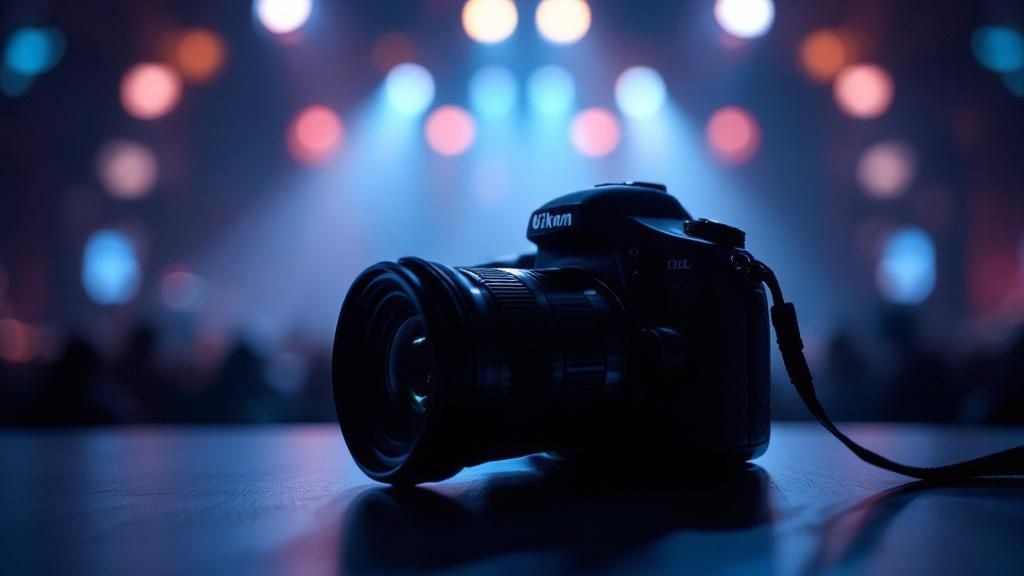
Let's get one thing straight: the idea of a single "best camera for event photography" just doesn't exist. It's a myth. The reality is, the right tool for the job depends entirely on the events you’re shooting. A camera that shines during a quiet corporate keynote might fall flat on a wild wedding dance floor.
This is where we go beyond just reading spec sheets and get into what actually matters on a gig. By matching a camera's real strengths to the specific challenges of your niche, you end up with gear that doesn't just work—it actively helps you get better shots. It’s all about finding a camera that solves the problems you face every single time you show up to an event.
Capturing Weddings Flawlessly
Wedding photography is the definition of a high-stakes gig. You're capturing fleeting moments that can't be repeated. There are no second chances for the first kiss or that tearful toast from a parent. Because of this, your camera choice really boils down to two things: flawless autofocus and discreet operation.
Modern mirrorless cameras with advanced eye-tracking autofocus are an absolute game-changer for weddings. Picture the bride walking down the aisle; a top-tier AF system will lock onto her eye and just stay there, giving you the freedom to think about composition and capturing the emotion of the moment.
On top of that, silent shutter modes are non-negotiable for ceremonies. The last thing anyone wants to hear during the vows is the loud clack of your mechanical shutter bouncing off the walls.
- Must-Have Features: Tenacious Eye-AF, a silent electronic shutter, dual card slots (for peace of mind!), and stellar low-light performance.
- Top Contenders: The Canon EOS R6 Mark II is famous for its incredible eye detection, while the Sony A7 IV's AI-driven tracking is almost spookily reliable.
- Why It Matters: Wedding clients are making a huge emotional and financial investment. Your gear has to be bulletproof enough to capture those memories and quiet enough to not become a distraction.
Choosing the right camera is a huge piece of the puzzle for a photographer. For couples, understanding the whole process is just as key. To see it from their side, you can learn more about how to choose wedding photographer and what they're looking for.
https://1021events.com/how-to-choose-wedding-photographer/
Excelling at Corporate Events
Corporate gigs bring a different kind of pressure. It's all about speed, efficiency, and professionalism. Clients often need photos yesterday for social media or a press release, which means your workflow in the camera is just as important as your work on the computer.
Here, features that speed you up are worth their weight in gold. A camera with excellent JPEG processing and great color science can save you hours in post. Solid connectivity, like fast Wi-Fi and Bluetooth, lets you send highlight shots to a client or social media manager right on-site.
These events are also all about versatility. One minute you’re getting a wide shot of a packed auditorium, the next you’re grabbing a quick, professional headshot of a CEO. A camera with a solid, all-around feature set is your best friend here.
- Must-Have Features: Great straight-out-of-camera color and JPEGs, fast connectivity, good battery life, and versatile autofocus that works in varied lighting.
- Top Contenders: Nikon cameras, like the Z6 II, get a lot of love for their comfortable ergonomics and pleasing skin tones. Meanwhile, Fujifilm's color science is legendary for producing beautiful JPEGs that need minimal-to-no editing.
- Why It Matters: In the corporate world, time is money and a polished image is everything. Your camera should be a tool that helps you deliver amazing results, fast.
Dominating Concerts and Sports
When your subjects are athletes flying across a field or musicians under chaotic stage lights, your camera needs one thing above all else: speed. This is a niche about capturing the absolute peak of the action, and that demands a blazing-fast burst rate with a deep buffer to back it up.
A camera that can fire off shots at 20, 30, or even 40 frames per second is your ticket to not missing the moment. But that speed means nothing if the buffer fills up after two seconds and you’re stuck waiting. A deep buffer lets you lay on that shutter button and capture entire sequences without the camera choking.
Low-light autofocus is also mission-critical, since you’ll be shooting in some of the toughest lighting conditions out there. Even when you know your gear, it never hurts to brush up on the fundamentals, and these tips for taking professional shots in specialized fields can help sharpen your technique for any challenging scenario.
Getting a Grip on Modern Camera Tech
To really nail down which camera is best for event photography, you have to look past the brand name and get into what's actually going on inside. Modern cameras are more than just light-catching boxes; they're packed with smart tech designed to solve the exact headaches you run into at live events, from dimly lit wedding receptions to chaotic conference floors. This is why mirrorless systems are pretty much running the show these days.
The biggest game-changer, without a doubt, has been AI-driven autofocus. And no, that's not just some marketing fluff. Today's cameras use serious machine learning to find and stick to subjects—not just faces, but eyes—with a tenacity that feels like cheating. Picture this: you're trying to track a speaker on stage while people keep walking in front of your shot. The AI helps the camera ignore the distractions and stay locked on, which means your keeper rate for sharp photos goes way, way up.
The Power of Stabilization and Sensor Size
Another feature that’s an absolute lifesaver is In-Body Image Stabilization (IBIS). This is where the camera's sensor literally shifts around to cancel out your shaky hands, letting you shoot at much slower shutter speeds without getting motion blur. For an event photographer, this is huge. It means you can grab crisp shots in dark venues without jacking up the ISO until it's a noisy mess or blasting a flash and killing the mood. It’s the difference between a blurry throwaway and a sharp, atmospheric photo.
High-resolution sensors also give you a practical edge that goes beyond making giant prints. A sensor with 30+ megapixels is like having a "fix-it-in-post" superpower for your composition. Did you frame a shot a little too wide while things were moving fast? No sweat. You can crop in tight later and still hand the client a high-quality image. It’s a crucial safety net when you can’t get the framing perfect on the fly. This tech is even being combined with other cool gear, like in drone wedding photography, to get those stunning, high-detail aerial views.
The real magic isn't just one single feature. It's how AI autofocus, IBIS, and high-res sensors all work together. This trio lets you stop worrying about the technical stuff and focus on what really matters: composition and capturing genuine moments.
This push in technology isn't happening in a vacuum. The photographic services industry in North America is on track to grow from USD 12.39 billion in 2025 to almost USD 15.38 billion by 2030, and AI-powered features are a huge reason why. You can dig into more of the numbers and trends on photographic services at Mordor Intelligence.
And let's not forget video. It's becoming a bigger and bigger part of event coverage. With social media highlights being a common client request, getting familiar with different formats is non-negotiable. For anyone creating clips for Instagram or TikTok, a creator's guide to vertical video dimensions is essential reading.
Your Top Event Camera Questions Answered
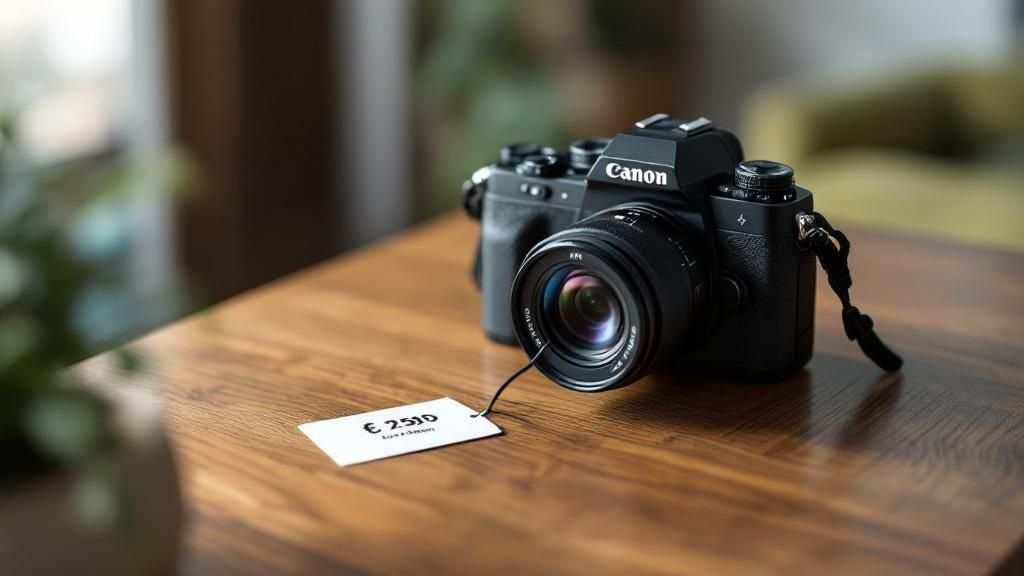
Dropping serious cash on a new camera is a big deal. It’s completely normal to have those last-minute doubts and questions before you commit. This section is all about tackling those common head-scratchers with some straight, practical advice from the field.
Think of this as the final check-in to make sure you're walking away 100% confident in your choice. We’ll get into the big debates and the tiny details that can make or break your workflow.
Is a Full-Frame Camera a Must-Have for Events?
This is the big one, and the honest answer is… it depends, but leans heavily toward yes. You don't technically need a full-frame camera to start, but there's a very good reason it has become the industry standard for pros. The magic is all in how it handles low light.
Full-frame sensors are physically larger than their APS-C (crop sensor) cousins, and that larger surface area soaks up more light. In a dim reception hall or a moody conference room, this means you can push your ISO higher and still get clean, usable images without a ton of distracting grain. You also get that dreamy, blurred-out background (bokeh) much more easily, which really makes your subjects stand out.
- The Full-Frame Edge: Absolutely crushes it in low light and gives you that beautiful subject separation with a shallow depth of field.
- The APS-C Advantage: The bodies and lenses are usually cheaper and lighter. They’re a perfectly fine place to start if the budget is tight.
Bottom line: if you're serious about making a career out of this, a full-frame body is an investment that pays for itself in client-wowing image quality.
For a professional event photographer, a full-frame sensor isn't really a luxury—it's a strategic tool. It gives you a massive advantage in the challenging, unpredictable lighting you'll face at almost every gig.
Are Dual Card Slots Really That Important?
Yes. 100% non-negotiable. This isn't about being fancy; it's about being a professional who doesn't lose a client's memories.
Events are live, one-shot deals. There are no re-dos for the "I do," the big award, or the keynote speech. Dual card slots write every photo to two cards at the same time. If one card fails—and trust me, they can and they do—you have an instant, complete backup on the other.
This one feature can save your job, your reputation, and a client's priceless moments. Any camera you're considering for paid work absolutely must have this. Don't even think about risking it with a single-slot camera.
Should I Buy a New or Used Camera?
This really comes down to a classic budget-versus-warranty battle. Going the used route can be an incredible way to step up to a much better camera than you could afford brand new.
- Buying New: You get the latest tech, a full warranty for peace of mind, and that fresh-out-of-the-box feeling with zero miles on the shutter.
- Buying Used: You can save a ton of money. Seriously. That cash can then go toward a killer lens, which often matters more. You can often snag a last-gen pro body for the price of a new mid-range one.
If you go used, stick to reputable shops that offer a return policy and at least a short-term warranty. Always ask for the shutter count—it’s like the odometer on a car. A well-cared-for pro camera has a lot of life in it.
Of course, having the right gear is only half the battle. You also have to know how to use it, which is why we put together these essential https://1021events.com/event-photography-tips/ to help you sharpen your skills.

